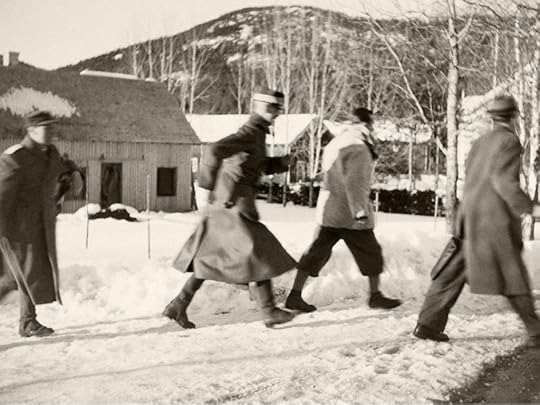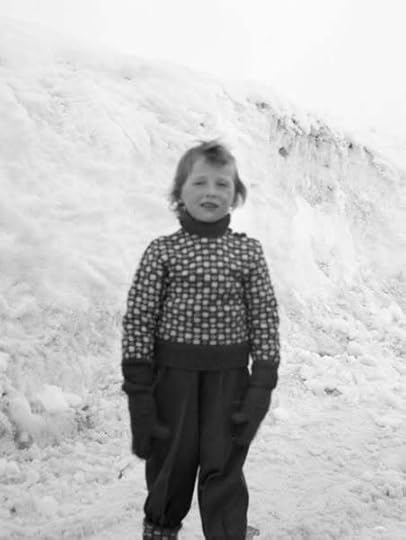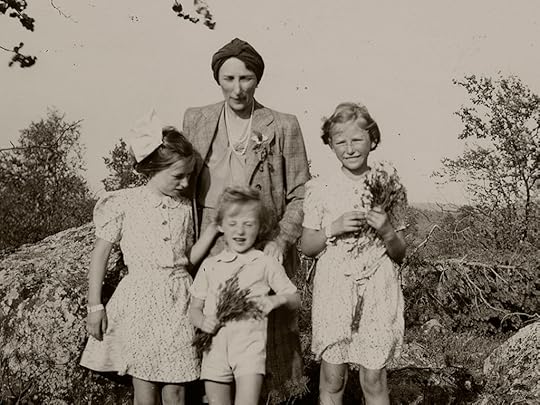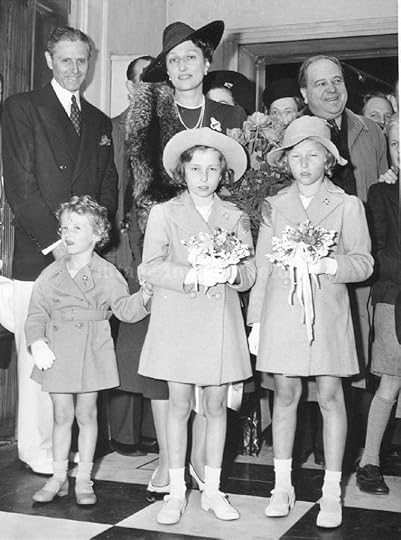Crown Princess Märtha’s Regency Battle
In the early hours of 9 April, Crown Princess Märtha and her husband Olav were awakened by a phone call from an aide, bringing the devastating news of an invasion by German military forces. With her mind in a whirl, Märtha immediately awakened her three children, instructing them to dress for a mountain hike. Ragnhild, the eldest, would later recall that ‘the clearest sign that something was wrong was that it was our parents themselves who woke us up.’ After eating a hasty breakfast, at around 6 a.m. Märtha , Olav and their three children (Ragnhild, Astrid and Harald) set out from their home, some twenty kilometres to the west of Oslo, for the Royal Palace in central Oslo, in a convoy of three cars. The Crown Prince was at the wheel of his own car, his wife and children beside him. Olav-who was driving at great speed-had already decided that if anyone tried to stop him, he would run them down.
On arrival at the Royal Palace, everything was in a state of flux. The royal family departed the royal residence at 7 a.m. travelling in the direction of the Østbane railway station in order to take a special train to Hamar to avoid capture. The members of the Norwegian parliament, the Storting, were also on board the train. The group was led and organised by the President, Carl Joachim Hambro. It had been at his suggestion that the royal family accompanied the parliamentary group. Just as the train passed through Lillestrøm, the town was bombed, although the focus was fortunately on the nearby airport at Kjeller. The entourage travelled onwards towards Hamar with German soldiers and aircraft in hot pursuit.
By the early evening, the royal party had settled at an estate at Sælid, a few kilometres outside of Hamar, where they were just sitting down to dinner when word was received from the local police chief of the impending arrival of several busloads of German paratroops. This was a group led by the German Air Attache in Oslo, Captain Spiller, who was intent on seizing the King and his ministers by force. They did not reckon on the efforts of the Norwegian Colonel Otto Ruge and his men, many of whom had only completed their basic training, who manned a roadblock. Their heaviest weapon was one machine gun. Fighting tenaciously, they succeeded in mortally wounding Hiller and the Germans withdrew. Meanwhile, the King and others of the royal group immediately set out by car towards Elverum, to rendezvous with members of the government who had fled there from Hamar. It was also at Elverum that the Storting gave the King and government the authority to govern the country for as long as the war lasted (“The Elverum Mandate”). However, with so much uncertainty prevailing, a decision was made to send Crown Princess Märtha and the royal children over the border into neutral Sweden, for reasons of safety. Among those accompanying them were Olav’s trusted aide, Major Nicolai Ramm Østgaard (who would almost immediately return to his duties with the Crown Prince), his wife Ragni and their ten-year-old son Einar. Also in the royal entourage was Signe Svendsen, Prince Harald’s nurse; as well as Ragnhild and Martha’s Swedish governess Maja Thorén. Another Swedish national, the Crown Princess’s maid, Edla Norberg completed the party. The royal convoy, consisting of three cars, crossed the border into Sweden from Trysil at 00:50 hours on 10 April.
 German troops parade down Karl Johan’s Gate with the Royal Palace in the background.
German troops parade down Karl Johan’s Gate with the Royal Palace in the background. The events surrounding the party’s crossing into Sweden are the subject of debate. There are two versions:. In Brita Rosenberg’s biography of Princess Astrid, the latter recounts that Swedish border guards did not want to raise the border barrier and only did so at the last minute when their Norwegian driver indicated that he would drive straight through unless they did so.
Einar Østgaard, in his 2005 book about Crown Princess Märtha, which makes use of his father’s notes and journals, takes issue with this account: ‘The claim that Crown Princess Märtha was denied access to Sweden was printed for the first time over forty years after crossing the border on the night of 10 April 1940.’ He is of the opinion that this version must be due to a misremembering. The author also cites his mother Ragni, who served as the Crown Princess’s Lady-in-Waiting, later describing an undramatic border crossing: ‘None of us had passports, but at the Swedish border station, Nikko (her husband, Nikolai Østgaard) was out explaining who it was, and there was no difficulty in getting past.’
Either way, the convoy continued to the winter resort of Sälen to stay at the well-known Högfjällshotellet, arriving at half past three in the morning. As it was a glorious sunny day and the royal children spent most of the time skiing on the nearby slopes, while their anxious mother remained at the hotel glued to the radio for news of events in neighbouring Norway. What she heard could hardly have lifted her spirits. On 10 April, the King had met with the German Minister Kurt Bräuer in the High School at Elverum. Bräuer set out the demands of his masters in Berlin: the legitimate Norwegian government must resign, and the King must appoint Vidkun Quisling of the right-wing Nasjonal Samling (National Unity) party as Norway’s Prime Minister and approve the formation of a pro-German government led by him. King Haakon subsequently presented these demands to officials of the legitimate Johan Nygaardsvold government during an extraordinary Council of State held in nearby Nybergsund (where they had relocated). The King made it clear that they must decide what course of action they wished to take, but added that he would not bow to these German demands and if the government decided to agree to them, he would abdicate. The government, in turn, fully backed the King. King Haakon’s “no” and the government’s approval thereof were formulated as a Royal Decree and signed by the King, the Prime Minister and Minister of State Bredo Rolsted. The Norwegian population were informed of the decision in a radio broadcast.
When the Germans learned of this decision (which was relayed by telephone to Bräuer at Eidsvoll by Foreign Minister Koht) , they were infuriated. The following day, Heinkel 111 bombers of the German Luftwaffe bombed both Elverum and Nybergsund, where the King and Crown Prince were sheltering, killing dozens of people. Crown Princess Märtha was subsequently relieved to learn from newly-arrived Norwegian guests at the hotel that, although shaken, both the King and Crown Prince Olav were uninjured. This news was corroborated by the hotel manager who had been in Nybergsund at the time of the attacks, in an attempt to obtain information on behalf of the Crown Princess. From first-hand reports carried in the Swedish press, it became clear that King Haakon was the key target. At one stage, he and his son Olav were forced to take shelter in a ditch to avoid being fired on by the low-flying Heinkel bombers.
 Crown Prince Olav (to rear) and King Haakon literally run for their lives at Nybergsund 11 April 1940
Crown Prince Olav (to rear) and King Haakon literally run for their lives at Nybergsund 11 April 1940An early visitor to Sälen was the Storting President Carl Joachim Hambro, who was en route to Stockholm. He recalls in his memoirs arriving in time for breakfast and apologising to the Crown Princess for ‘being so unkempt and not having had time to shave.’ Märtha, clearly having maintained her sense of humour merely laughed and replied, ‘Me neither.’ He brought with him a letter written by King Haakon at Nybergsund addressed to his sister (and Märtha’s mother) Princess Ingeborg. The latter arrived at the winter resort a few days later, visibly tired and looking somewhat older, according to Ragni Østgaard. Yet, Ingeborg was also ‘filled with a glowing hatred of the Germans’ for her homeland of Denmark had also recently been occupied. Märtha’s mother was also deeply concerned for the welfare of her brother, King Haakon (formerly Prince Carl of Denmark until his accession to the throne of Norway in 1905) and her son-in-law (and nephew) Olav.
 Prince Harald photographed at Sälen
Prince Harald photographed at SälenThe Swedish authorities were by now growing increasingly nervous of the presence of Norwegian royalty in an area so close to the border. What if, they reasoned, the Germans accidentally bombed the hotel due to a “navigation error” or if a kidnapping attempt was made to seize the royal party? The Swedish county governor decided to act and asked the royal party leave the hotel. In order not to attract attention, on 18 April, the royals and their entourage departed in the middle of the night, and headed southwards by car (which almost upturned in a snow drift) towards Uppsala. Thanks to Princess Ingeborg making use of family connections, it was arranged that the royal party could take temporary residence at Count Carl Bernadotte of Wisborg’s home at Rasbo. They would remain there for ten days, before proceeding to Stockholm and Drottningholm Palace.
At Drottningholm, King Gustav proved to be welcoming host but made it clear, through an adjutant, that there would be no discussion of the war at the dinner table. This was interesting, as otherwise Gustav had taken a keen interest in developments throughout Europe, with maps spread out over a billiard table nearby. However, it was noticeable that there was none pertaining to Norway. This particular map had been removed, prior to the arrival of the Norwegian contingent, perhaps out of tact. The Crown Princess tried to distract herself with games of gin rummy and bridge. Meanwhile Norwegians in Sweden were told not to openly celebrate their National Day on 17 May.
So how did the Crown Princess now continue to obtain news of what was happening across the border? Märtha acquired a quality radio set and each evening she and Ragni Østgaard would listen to the late night news bulletin from London. Perhaps Märtha even managed to tune in to the National Day service broadcast from the Norwegian Seamen’s Church in London, as King Haakon and Crown Prince Olav managed to do in a holiday chalet in Northern Norway? She also had the services of the Norwegian diplomat Jen Bull, who acted as a liaison between Märtha and the Norwegian Legation in Stockholm. Bull had previously served (1925-1931) as a Counsellor in the Norwegian legation in Berlin, rising to the rank of Under-Secretary of State at the Foreign Office in Oslo in 1939.
In due course, the Crown Princess was informed that King Haakon and Crown Prince Olav had departed Norway (from Tromsø) on the evening of 7 June, following a cabinet meeting held in the Bishop’s Palace, in order to continue the fight from Norwegian democracy from London. The war in Norway aside, Crown Prince Olav’s chief concern was now for the safety of his children and wife in Sweden. He had written to President Franklin D Roosevelt from Trangen, Langvatnet, as early as 10 May, mentioning an offer which Roosevelt had made, in late April 1939, during the Crown Prince and Princess’ weekend stay at the President’s country home at Hyde Park, ‘to take care of the children’ if the war should reach Norwegian shores.
After observing the 82nd birthday celebrations for ‘Uncle Gustav’ the previous day at Drottningholm, on 17 June, the Crown Princess and her children moved to Ulriksdal Palace. This allowed for some more privacy, and the children were able to relax with games, picnics and boating on the inlet. Furthermore, young Harald took the opportunity to learn to swim under the instruction of Signe Svendsen. Nonetheless, there was always a watchful Swedish policeman in attendance. Interestingly, the move to Ulriksdal coincided with King Haakon learning that the Germans had informed the Administrative Council, an interim body appointed by the Norwegian Supreme Court to deal with matters of civil administration in Norway, that he should abdicate the throne. This move on the part of the German occupiers seems to have hit a raw nerve with King Gustav of Sweden who, most unusually, became involved, sending a telegram to Adolf Hitler stating that ‘I consider it my duty to personally emphasize to you, Herr Reich Chancellor, that such a measure would elicit serious disapproval among the broadest circles of the Swedish people and throughout the whole of Scandinavia. I wish therefore, before irrevocable decisions are made by you, to draw your attention through this telegram…to urge you, Mr. Chancellor, to proceed with all the moderation that can be considered possible in relation to Norway, its king and people.’ Did he now fear for his own throne?
 The sitting room at Ulriksdal Palace much as it was in 1940.
The sitting room at Ulriksdal Palace much as it was in 1940.In the interim, Berlin had appointed Josef Terboven as Reichskommissar in Norway. Despite the initial refusal of the Administrative Council to comply with the abdication request, negotiations were continuing with Terboven, who was currently focused on the formulation of a future political framework for use in Norway during the occupation. Furthermore, despite King Gustav’s aforementioned telegram, there was a genuine possibility that a powerful Germany, aided by sympathetic Norwegians, could, if necessary, use leverage against Sweden, both diplomatically, economically, and militarily, to arrange for Märtha to be returned to Norway with her son and a Regency formed until Harald came of age. A number of prominent Norwegians who visited Stockholm advocated for such a solution. This idea also had its supporters within Per Albin Hansson’s Swedish government. For instance, the Swedish Justice Minister (and one-time Foreign Minister), Karl Westman, wrote in his diary as early as 19 June, mentioning his attendance at a government meeting: ‘I reiterated my question about why the friends of the Norwegian dynasty do not put the Norwegian crown princess and [prince] Harald on a plane and send them… to Oslo.’ He was writing this at a time when many Swedes believed that Märtha’s presence threatened to undermine Sweden’s neutrality when Germany was on the ascendance: Only a few days earlier German forces had entered Paris unopposed and the French were on the point of signing the surrender at Compiègne. Time Magazine would subsequently report that Crown Princess Märtha had indeed been offered ‘a regency in the name of her son, Prince Harald.’ Meanwhile, some Norwegians even harboured the-not unrealistic-suspicion that Prince Harald could be kidnapped and taken to Oslo by force.
On 27 June, the Presidential Council of the Storting, under pressure from the occupiers and recognising the need to establish a provisional government, responded tentatively to Josef Terboven’s proposal to establish a Council of the Realm to act as a collaborative body with the occupiers. In order to progress matters, they now asked the King to abdicate, giving him until 12 July to ‘renounce his constitutional functions for himself and his house.’ However, King Haakon refused to comply and, on 8 July, announced his rejection of the abdication request via a BBC radio broadcast from London, as well as formally placing his response in writing. What would this mean for the future of Norway and the monarchy going forward?
In Stockholm, Märtha, under the impression that her Swedish family (i.e. King Gustav) and Hitler were conspiring to remove King Haakon and set up a Regency, was feeling the pressure and sent a telegram to London as early as 24 June warning her husband that attempts were being made to ‘induce her’ to return with her three children to Oslo. Indeed, rumours had been circulating of a cipher telegram having been sent on 21 June by King Gustav to King Haakon to advise him to abdicate in favour of his grandson as ‘a means of saving the Norwegian people from unnecessary difficulties’. It also appears that the contents of King Gustav’s earlier telegram to Hitler may have been misconstrued or misreported for, on 22 June the British Minister in Stockholm indicated that King Gustav had telegraphed Hitler directly personally recommending the Regency option to him. Thus, London (and the Crown Princess) now believed that Gustav was the principal protagonist in this matter. Indeed, such was the fury in London that it caused Britain’s King George VI to sit down and write a very stern letter to the Swedish King. Fortunately, this was not forwarded by the British Legation in Stockholm to King Gustav, when it became clear that the meddling Swedish king had instead urged Hitler to show the utmost possible moderation in his dealings over Norway. Some commentators have taken the view that Gustav intervened simply because he believed that if the matter was not resolved soon Germany would abolish the monarchy in Norway.
Despite the strong political pressure placed on her, according to Einar Østgaard’s book, Crown Princess Märtha did not particularly want to travel to the United States. However, King Haakon and Crown Prince Olav, fearing for Märtha and the children’s safety, seemed keen that this should happen. In late June, the Crown Prince had written again to President Roosevelt from Buckingham Palace pressing him to make good on his offer of sanctuary to his children, but this time he also included a request on behalf of his wife. Olav also made an approach to the US Secretary of State via the US Ambassador in London, Joseph Kennedy, entreating ‘if there is anything you can do in a hurry to get the [Crown] Princess out [of Sweden].’ On 12 July, the US Secretary of State sent a message to the US Minister in Stockholm saying that President Roosevelt was arranging for a naval transport vessel to be sent to Finland to evacuate the Crown Princess and her family, along with a group of ‘stranded’ US citizens.
On 17 July, the Norwegian Government-in-exile addressed a letter to the Storting Presidential Council, in which cautious appreciation of the work done by the Administrative Council was combined with a plain warning that ‘everything which is agreed or done at this time in respect of government in Norway must have the clear stamp of temporariness, if nothing is to be lost for the future of the country.’
On 18 July, Märtha received a telephone call from the Norwegian Minister in Washington, Wilhelm Thorleif von Munthe af Morgenstierne. He informed a somewhat nonplussed Crown Princess (who seems to have been in the dark about Crown Prince Olav’s recent correspondence with Roosevelt) that an American warship was being sent to Finland to transport her and her children to the United States. But would she go? On 20 July, Märtha received the US Minister to Norway, Mrs Florence Harriman, who was now ensconced temporarily at the United States Legation in Stockholm. Having had time to reflect on the efforts being made on her and her children’s behalf, both in London and Washington, the Crown Princess indicated to the American that she would be happy to accept President Roosevelt’s kind offer. Nevertheless, Märtha was keen to emphasise that she wanted to enter the United States ‘as quietly as possible’ and that she ‘would not be required to meet reporters or a reception committee’. Naively, the Crown Princess even expressed the hope that the date of her arrival should be kept confidential. King Gustav, on hearing of the “American plan”, telegraphed King Haakon, on 24 July, stating that he objected to the American trip as it might undermine the future of the Norwegian monarchy, a viewpoint Haakon, who deeply resented Gustav’s meddling, was quick to dismiss. Some sources also have Crown Princess Märtha and “Uncle Gustav” having a robust exchange of views on this matter in Stockholm.
However, events were already moving apace. On 22 July, Mrs Harriman had been informed by the US State Department that a naval transport, the USS American Legion, was about to leave for the Finnish port of Petsamo (now Petsjenga, Russia) and should reach there around 5 August. It was also made clear that there was ‘no possible way’ the Crown Princess’ arrival in the United States could be kept confidential. Indeed, just as Märtha was setting off from Ulriksdal Palace, on 12 August, the Norwegian Legation released a statement to the press, also broadcast over Radio Sweden, stating that the Crown Princess and her three children ‘will leave for the United States in the next few days to visit President Roosevelt’ who had issued ‘a personal invitation’ to the Norwegian royals.
That same day, the Norwegian party departed Stockholm’s Central Station. Both Märtha’s father, Prince Carl and Princess Ingeborg were distressed to take leave of their beloved daughter and grandchildren. Princess Ingeborg presented Märtha with a case of jewels, including the emerald tiara that had once belonged to Empress Joséphine, the wife of Napoléon Bonaparte. This was a form of financial insurance in difficult times. King Gustav also came to the station to see them off, despite his grave reservations. They were, after all, his relations too. The plan was for the Norwegian royal party to travel by train to Haparanda, on the Swedish/ Norwegian border, with the rest of the journey, through Finland, being undertaken by cars provided by the Finnish authorities. The local Haparanda newspaper Haparandabladet soon reported on the Crown Princess’s arrival there, prior to her setting off on the second stage of the journey northwards to Petsamo. This second stage was undertaken in a convoy of four vehicles and included stops and overnight stays in Rovaniemi and Inari (Enare). A Finnish military officer, Major Carl Gustaf Wahren, accompanied the royal entourage and was responsible for security. He very kindly allowed the amiable Swedish policeman Artur Pfeiffer, with whom the children had developed a good relationship since their arrival in Stockholm, to accompany the party on this Finnish leg of their journey. Petsamo was reached on 15 August.
 The Crown Princess and her children in Finland en route to Petsamo, 13-15 August 1940
The Crown Princess and her children in Finland en route to Petsamo, 13-15 August 1940The Crown Princess and her children now joined the nine hundred passengers, mostly United States citizens, aboard the American Legion, bound for New York. Märtha appeared on the ship’s manifest as “Mrs Jones” and was given the use of the Captain’s cabin. Others in the royal party included the Crown Princess’s Chief of Staff, Peder Anker Wedel Jarlsberg; Lady-in-Waiting, Mrs Ragni Østgaard; the latter’s son Einar and Prince Harald’s nurse, Signe Svendsen. Touchingly, Harald was pictured clutching his beloved teddy bear. Yet, the Norwegian royal party were still very much in danger. Germany refused to guarantee the ship safe conduct and according to Time Magazine, in a ruthless last-minute display of audacity, had tried to delay the sailing with a dispute over the route. It was said that the Germans preferred a more northern passage where the American Legion could be waylaid by a submarine, and Martha and her son kidnapped.
Meanwhile, King Haakon broadcast to the Norwegian people on 26 August, informing them ‘to avoid everything which is inconsistent with our national dignity; remain Norwegian in mind and thought…’ A majority of the Storting members in Oslo eventually voted for the suspension of the monarchy rather than acceptance of the original German demand for the abdication or deposing of the Royal House and negotiations continued. However, Terboven, keen to stamp his authority, eventually abandoned plans for a Council of the Realm. On 25 September 1940, he proclaimed the abolition of the monarchy, the deposition of the Nygaardsvold government, and the dissolution of all political parties with the exception of the Nasjonal Samling. Furthermore, he also terminated the activities of the Administrative Council and set up a body of pro-German personalities and power rested, for the moment, with the Reichskommissariat.
Despite all the melodrama of the last few months, the Crown Princess and her entourage finally sailed into New York on 28 August. She and her three children would eventually settle in a largish brick house set in substantial grounds in Pook’s Hill, Maryland. Märtha would soon become part of President’s Roosevelt’s inner circle and was thus ideally placed to obtain first-hand knowledge of the comings and goings at the White House and in Washington’s political circles. She was also able to use her position to advance Norway’s cause in the United States.
 The Crown Princess and her family arrive in New York 28 August 1940
The Crown Princess and her family arrive in New York 28 August 1940



